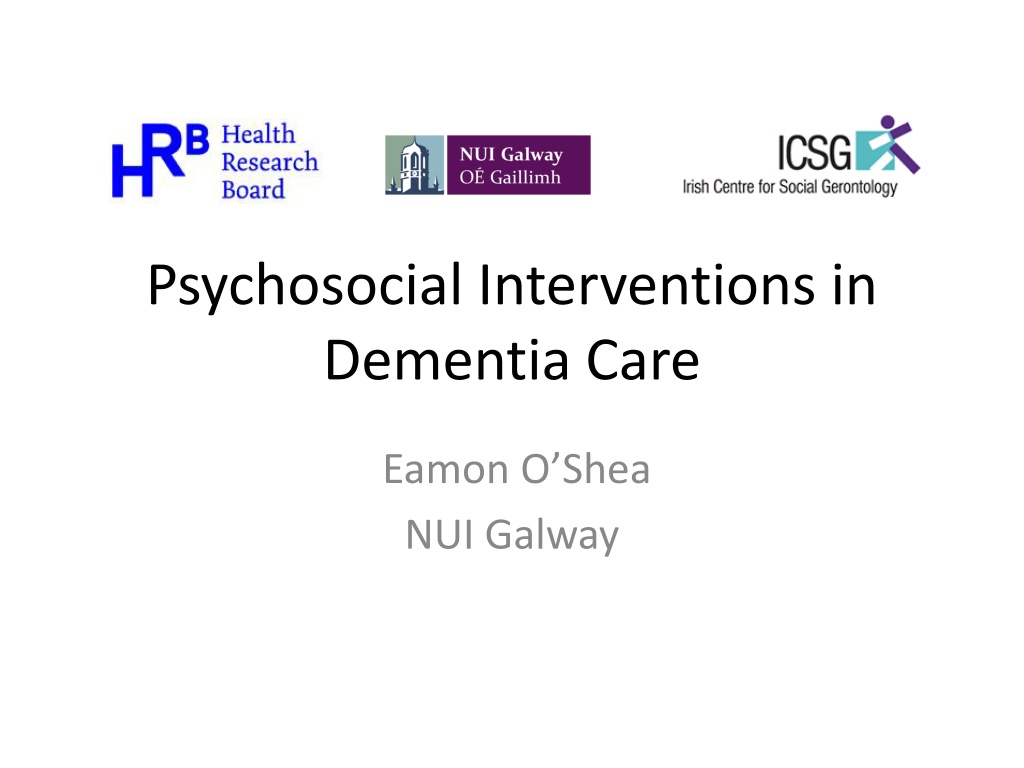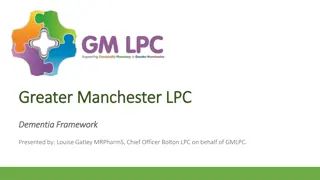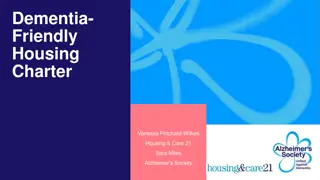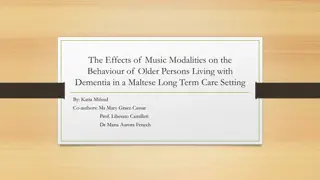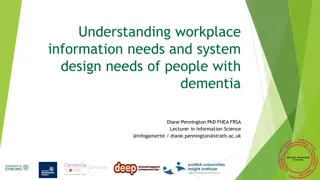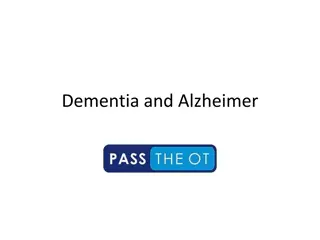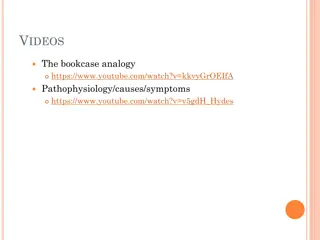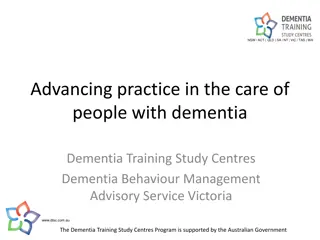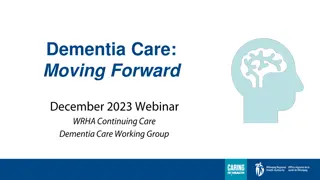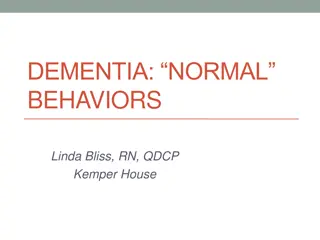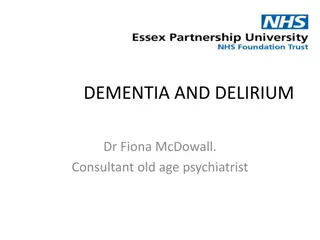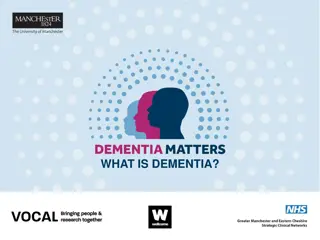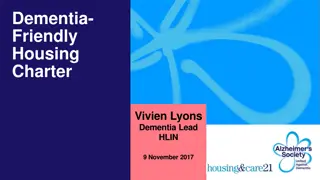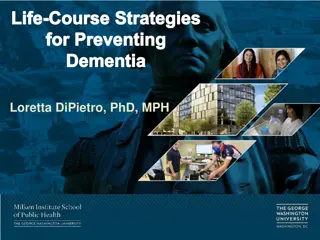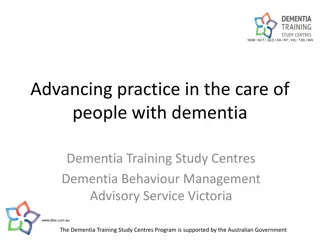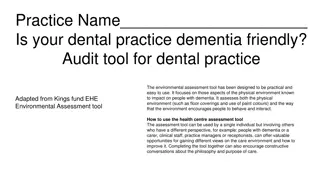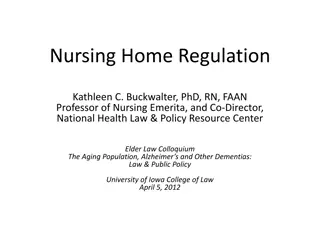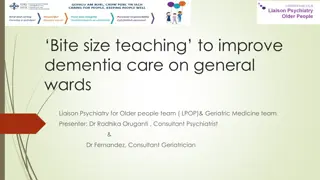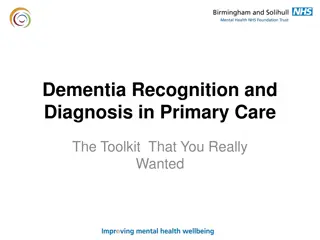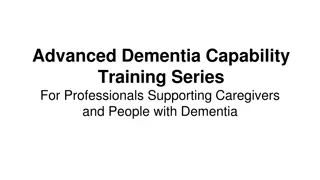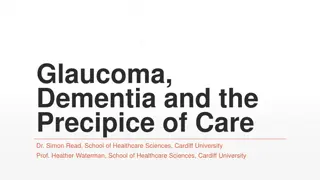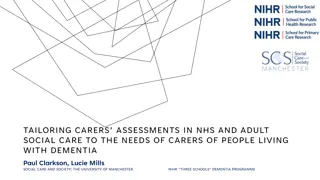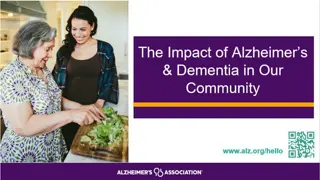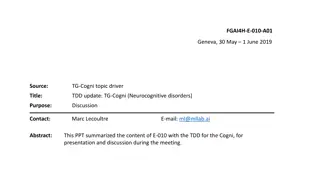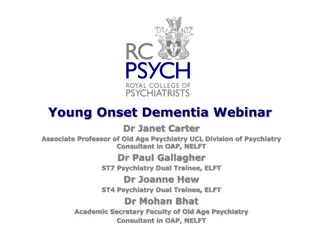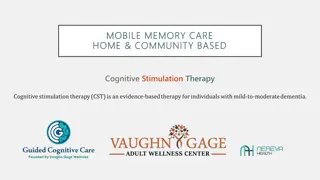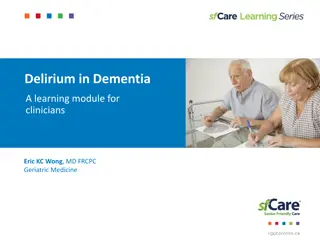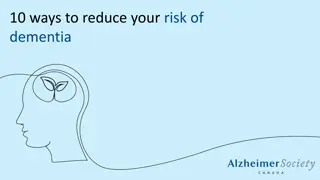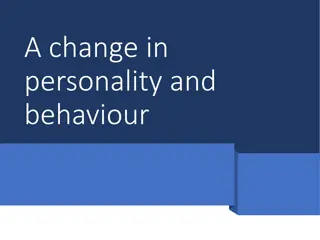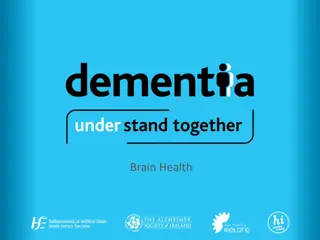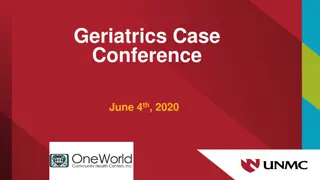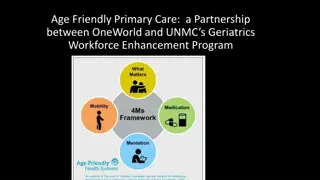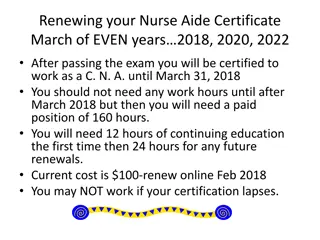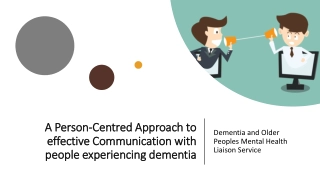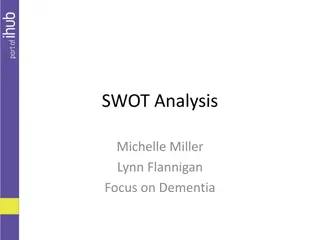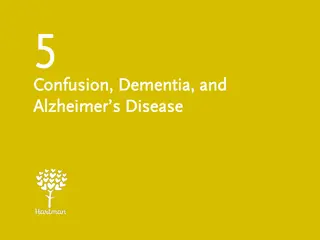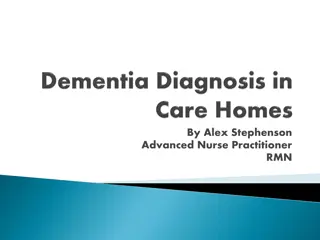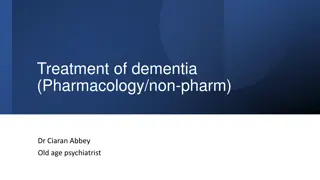Understanding Dementia Care: Insights and Challenges
Psychosocial interventions play a crucial role in dementia care, with increasing global prevalence rates and substantial economic costs. In Ireland, the burden of dementia is rising, highlighting the need for effective prevention strategies. Population aging, informal care, and residential care are key drivers of expenditure in dementia care. Mitigating risk factors such as cardiovascular issues and promoting community-based care are essential in addressing the challenges posed by dementia.
Download Presentation

Please find below an Image/Link to download the presentation.
The content on the website is provided AS IS for your information and personal use only. It may not be sold, licensed, or shared on other websites without obtaining consent from the author. Download presentation by click this link. If you encounter any issues during the download, it is possible that the publisher has removed the file from their server.
E N D
Presentation Transcript
Psychosocial Interventions in Dementia Care Eamon O Shea NUI Galway
Dementia Worldwide An estimated 47 million people live with dementia in 2015 worldwide The worldwide economic cost of dementia was an estimated US$808 billion in 2015 Less than 20% of these costs are attributable to direct medical care Informal care is the main cost source 40% to 60%
Dementia in Ireland There are currently an estimated 55,000 people with dementia in Ireland Rising to 94,000 in 2031 Rising to 152,000 in 2046 Average cost per person with dementia estimated at 40,500 in Ireland Total burden an estimated 1.9 billion Acute care additional costs estimated at 0.2 billion Informal care accounts for 50% of overall costs of care
Drivers of Expenditure in Dementia Care Population ageing is the main driver of demand for long-term care. We are living 2 years longer every decade Informal care and residential care driving costs Higher costs at end-of-life than other diseases like cancer or heart disease Family sizes are declining, while female workforce participation is increasing leading to a potential decline in the availability of informal carers
Prevention- Mitigating Risk Factors Cardiovascular (hypertension, obesity, diabetes, atrial fibrillation) Physical activity Depression Traumatic brain injury Sleep quality Dementia prevalence rising but incidence may be flattening/declining 6
Balance of Care The majority of people with dementia live in their own homes in the community - mainly undiagnosed Most people wish to remain living in their own homes for as long as possible and practicable Two thirds plus of all expenditure on dementia occurs in residential care settings Variation in the balance of resources invested in nursing home care and community-based care often determines where care for older people is provided Community care equals family care; residential care maximises public funding potential
What Do We Know? People with dementia have a strong preference towards remaining at home in their communities The current provision of formal care in the community is fragmented, and often lacks the flexibility and specificity to address the changing needs of people with dementia Providing appropriate support to carers can reduce caregiver burden and enhance the family commitment to caring Measurement of value in dementia care is poor Prevention matters Models of care matter
Biological Model Biological model presents a clinical perspective Dementia as a clinical syndrome is characterised by global cognitive impairment, which represents a decline from previous level of functioning, and is associated with impairment in functional abilities and, in many cases, behavioural and psychiatric disturbances, (NICE Mental Health Guidelines, 2007) Person with dementia as patient to be treated Necessary but not sufficient 9
Personhood in dementia Kitwood defines this through relationships a standing or status that is bestowed upon one human being by others, in the context of relationship and social being Dewing personhood can be understood as the attributes possessed by human beings that makes them a person
Citizenship Citizenship is traditionally defined in the social science literature as a status bestowed on those who are full members of a community. All who possess the status are equal with respect to the rights and duties which the status bestows, (Marshall) A citizen is defined by the acquisition of, and participation or inclusion in, the country or community in which they live, (Gould) 11
Social Model of Dementia The social model of care seeks to understand the emotions and behaviours of the person with dementia by placing him or her within the context of his or her social circumstances and biography. By learning about each person with dementia as an individual, with his or her own history and background, care and support can be designed to be more appropriate to individual needs, (NICE Mental Health Guidelines, 2007) 12
Biopsychosocial Model Spector and Orrell (2010) argue the need for a pragmatic, user- friendly model of care which takes into account the biological, psychological and social aspects of dementia. Biological factors are defined as: Age, health prior to dementia, genetic factors, physical health, sensory impairment Psychosocial factors include: Education/IQ, mental stimulation, mood, reaction to life events, previous life events, personality traits, environment, social psychology, personal psychology Biopsychosocial approach needed to understand the factors influencing context and dynamic of impairment in dementia Evidence base for psychosocial interventions for people with dementia is evolving but much to do 13
Psychosocial Theoretical Foundations Rooted in personhood/person centredness, autonomy, dignity, respect, communication, understanding dementia processes and symptoms Concerned with human interactive behaviour between providers/families and the person with dementia (PWD) Reciprocity and integration mediated within a social context
History Relatively new origins in 1960 s and Reality Orientation work But few studies emerged pre-2000 mostly small-scale, short-term, diverse, opportunistic and site-specific Absence of theoretical frameworks Difficulty of undertaking RCT s methodological issues replication difficult Absence of appropriate outcome measures Inadequate research funding
Psychosocial Domains: American Psychiatric Association Behavioral approaches identify antecedents and consequences of problem behaviors and attempt to reduce the frequency of behaviors by making changes in the environment (e.g. regular toileting) Stimulation-oriented recreational activity, art, music or pet therapy aim to maximize pleasurable activities Emotion-oriented supportive psychotherapy, reminiscence, validation therapy, sensory integration, simulated presence therapy Cognition-oriented focus on specific cognitive defects: reality orientation, cognitive retraining, skills training
Typical Outcomes Quality of life person with dementia (QoL-AD scale) DEMQOL Activities of daily living (Bristol ADL) Depression (Cornell scale for depression in dementia (CSDD)) Autobiographical memory (autobiographical memory interview (AMI(E)) Agitation ((Cohen-Mansfield agitation inventory (CMAI)) Anxiety (rating anxiety in dementia (RAID) and hospital anxiety and depression scale (HADS)) Caregiver burden (Zarit burden interview) Personhood the self 17
Psychosocial Guidelines Across Countries Inclusion of psychosocial interventions in dementia guidelines across Europe is limited Guidelines for psychosocial interventions found in only small number of countries UK NICE guidelines had best methodological quality and included most recommendations (e.g. recommend the use of group Cognitive Stimulation Therapy for people with mild to moderate dementia, irrespective of drug treatments received). Physical activity and carer interventions recommended most often across all guidelines Even when guidelines exist physicians tend to recommend pharmacological interventions far more often
Focus on Reminiscence Cochrane Review concluded that there was uncertainty in relation to the effectiveness of reminiscence therapy and called for more and better designed trials in the area Five trials but in total only covered 144 participants Inconclusive evidence on effectiveness Some evidence of improvement in cognition and in mood, as well as decrease in caregiver strain Recent work in Ireland on reminiscence Structured education programme for staff in long-stay care settings (Int.Journal of Geriatric Psychiatry)
Effect estimates: intention to treat ( ITT) and per protocol (PP) analysis ITT Estimated effect (95% confidence interval (CI)) 3.54 (-0.83, 7.90) PP Estimated effect (95% confidence interval (CI)) 5.22* (0.11, 10.34) Qol-AD resident score QoL-AD caregiver score CMAI score CSDD score MZBI score nurse MZBI score care assistant 1.14 (-0.35, 3.62) 1.40 (-1.75, 4.55) -3.35 (-8.10, 1.82) -2.14 (-7.94, 3.67) -0.86 (-2.66, 0.93) 1.50 (-0.73, 3.74) -1.33* (-3.04, -0.36) 0.97 (-1.13, 3.08) 0.42 (-1.82, 2.67) 0.86 (-1.22, 2.94) * P < 0.05
Discussion Large, robust trial showing potential of reminiscence in the treatment of those with dementia Per protocol results on QoL-AD exceeded minimum clinically important difference of 4 points Pragmatic nature of trial meant adherence to protocol not always or easily achieved More trials required to determine if similar effects of reminiscence are found in similar populations in other countries
Emerging Consensus? Biopsychosocial model Citizenship and rights Personhood and person-centred care Awareness and reducing stigma Pathways to care from diagnosis to end of life care Prevention and brain health 22
The New Paradigm Personhood not patient/client Prevention as much as cure Capabilities more than risk Inclusion (citizenship) not exclusion Social as important as biological Biopsychosocial model
